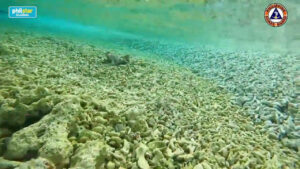There were gushing descriptions and awesome pictures of bountiful marine life in the National Geographic magazine of May 12, 2022, that featured the coral reefs in the Philippines. Tubbataha Reefs, a national park and UNESCO World Heritage site in the center of the Sulu Sea, has been slowly revived after it was all but destroyed by blast fishing in the 1960s. But how can coral reefs be preserved at a time not just of increasing exploitation but also of human-driven changes in the very ocean itself, the magazine asks? Warming seas, acidifying seas, rising seas — these are the darker shadows that fall across the world’s coral reefs. The most diverse ecosystem in the ocean — a planetary feature for 240 million years — will start to disappear. “It is projected that by 2050 more than 90% of the global Coral Triangle’s reefs will be critically threatened by climate impacts,” the magazine warns.
All the gushing turns to dread for the severely exploited and damaged coral reefs. The West Philippine Sea has an estimated 4,640 km2 or 464,000 hectares of coral reef (based on the CARE-CaDRES Report 2019). The Philippines is believed to have the third largest reef area and the most diverse coral reefs in the world.
Why are coral reefs important? The US National Oceanic and Atmospheric Administration (NOAA) tells us that coral reefs are some of the most diverse ecosystems in the world. Because of the diversity of life found in the habitats created by corals, reefs are often called the “rainforests of the sea.” About 25% of the ocean’s fish depend on healthy coral reefs. Reef ecosystems can support more than 7,000 species of fish, invertebrates, plants, sea turtles, birds, and marine mammals.
“The Philippines is one of the world’s 18 mega-biodiverse countries — the archipelago contains two-thirds of the earth’s biodiversity and between 70% and 80% of the world’s plant and animal species. It is home to 505 coral species and 915 reef fish species. The country is the world’s third most coral-rich area after Indonesia and Australia” according to the Convention on Biological Diversity (bworldonline.com, June 29, 2018).
A square meter of a healthy coral reef produces one to five kilograms of white sand per year, making reefs an even more vital component of coastal tourism. And since coral reefs are natural wave breakers, they protect coastal communities from tidal waves, strong currents, and storm surges (philchm.ph). They protect coastlines from storms and erosion, provide jobs for local communities, and offer opportunities for recreation. They are also a source of food and new medicines. Over half a billion people depend on reefs for food, income, and protection. Fishing, diving, and snorkeling on and near reefs add hundreds of millions of dollars to local businesses. The net economic value of the world’s coral reefs is estimated to be nearly tens of billions of US dollars per year. These ecosystems are culturally important to indigenous people around the world (noaa.gov).
The Philippines is aware of the threats to its coral reef ecosystem, but more to protect its fisheries, the National Geographic article candidly says. If the corals die, fish will have no sanctuary wherein to spawn. Since the 1970s, community-managed marine protected areas (MPAs) have been set up as reserves (no-fishing areas) so as not to disturb and damage the coral ecosystem. Municipalities have jurisdiction over their coastal waters out to 15 kilometers and local fishermen freely enjoy the spill-over fish from the MPAs. Most of the Philippines’ more than 1,600 MPAs are small and locally managed, but enforcement is uneven according to the magazine’s evaluation. More than a million fishermen depend on the country’s coral reefs, but today 54% of the reefs are badly damaged (oceana.org, May 22, 2017).
PHILIPPINES-CHINA TENSIONSThe Philippines-China tensions in April 1992 were sparked by illegal fishing and damaging the reef-sanctuaries in the Philippines’ exclusive economic zone (EEZ). A Philippine Navy surveillance plane spotted eight Chinese fishing vessels anchored in the waters of the Scarborough Shoal. The Filipino inspection team that boarded the fishing ships claimed that they discovered illegally collected corals, giant clams, and live sharks. They attempted to arrest the Chinese fishermen but were blocked by Chinese maritime surveillance ships — it was a stand-off (Philippine Daily Inquirer, April 11, 2012).
Diplomatic protests were ignored by China and failed initial attempts at reciprocal fishing bans escalated with the stepped-up presence of Chinese fishing and patrol vessels in Scarborough Shoal. Chinese water cannons were focused on small Filipino fishing boats that slipped through the Chinese barriers, to fish for food more than for sale. And the Chinese continued to fish and poach coral in Scarborough Shoal.
On March 30, 2014, the Philippines submitted a case against China to the Permanent Court of Arbitration in The Hague over competing South China Sea claims, invoking the compulsory settlement of dispute clause under the Law of the Sea Convention.
China refused to participate in the arbitration, calling instead on bilateral negotiations to be used to resolve border disputes. Its refusal did not prevent the arbitral tribunal from proceeding with the case. On July 12, 2016, the Arbitral Tribunal in the South China Sea Arbitration (The Republic of the Philippines v. The People’s Republic of China) issued a unanimous award largely favorable to the Philippines.
The Tribunal ruled: “China has, through the operation of its official vessels at Scarborough Shoal from May 2012 onwards, unlawfully prevented Filipino fishermen from engaging in traditional fishing at Scarborough Shoal.” (PCA Award, Section VII(C)(5)(c)(814), p. 318.)
“The award of the arbitration is illegal, null and void. It is nothing more than a piece of wastepaper,” Foreign Ministry spokesperson Zhao Lijian said in a press conference in Beijing on July 12 (onenews.ph, July 13, 2021). He was basically repeating what President Rodrigo Duterte said about the Arbitral Award to the Philippines: “That paper, in reality between nations, that paper is nothing. Whoever is tough, the United States, the United Kingdom, they can do whatever they want. We won. When I came into office the ships were already in the West Philippine Sea, Chinese boats, we have nothing” (Philstar.com, May 6, 2021).
Earlier in 2019, President Duterte made confusing statements about allowing China to fish in our waters “because we (China and the Philippines) are friends.” Supreme Court Senior Associate Justice Antonio Carpio, one of the Philippines’ leading experts on the West Philippine Sea who helped craft and submit Philippines vs. China to the Arbitral Tribunal, pointed out that Duterte was wrong: “The Philippine government cannot allow Chinese fishermen to fish in Philippine exclusive economic zone (EEZ) in the West Philippine Sea because it will violate the Constitution.” Justice Carpio quoted the Constitution, “The State shall protect the nation’s marine wealth in its… exclusive economic zone, and reserve its use and enjoyment exclusively to Filipino citizens” (Rappler, June 25, 2019).
The Philippines has lost 3.6 million kilos of fish due to the presence of Chinese fishing vessels in the West Philippine Sea, according to estimates from food security advocacy group Tugon Kabuhayan (bworldoline.com, May 3, 2021). China has the largest fishing fleet in the world, with about 220,000 huge steel-hulled trawlers as opposed to Filipino fishermen’s wooden boats. In 2019, UP oceanographer Deo Onda estimated that the Philippines was losing around P33.1 billion annually from the damaged reef ecosystems in Panatag Shoal and the Spratlys Islands due to China’s reclamation activities (Philstar.com, Sept. 20, 2023).
Early this month, the Philippine military revealed a resurgence of Chinese swarming activity in the West Philippine Sea. The Coast Guard and Armed Forces reported “severe damage inflicted upon the marine environment and coral” at the Iroquois Reef, where it said 33 Chinese vessels had been moored in August and September. China, which has refused to recognize the 2016 ruling and has chafed at repeated mention of the case by Western powers, denied the latest claims of destruction of coral reefs (Reuters, Sept. 22, 2023).
Solicitor General Menardo Guevarra is studying the possibility of filing a second legal case before the Permanent Court of Arbitration (PCA) in the Hague. This is driven “not only by the alleged destruction of reefs but also by other incidents and the overall situation in the West Philippine Sea,” Guevarra told Reuters, adding that a report and recommendation would be sent to President Ferdinand Marcos, Jr. and the foreign ministry.
Justice Carpio recommends instead that the Philippines submit the conflicting claims in the Spratly Islands to voluntary arbitration in the International Court of Justice (ICJ), the principal judicial organ of the United Nations (UN) on international law. “All the other countries involved in the dispute — China, Vietnam, Malaysia, and Brunei — must agree to bring the issue to the ICJ. Brunei usually follows the lead of China,” Justice Carpio said. (Verafiles.org, Sept 23, 2023).
God willing, there would be peace at last in the West Philippine Sea.
Amelia H. C. Ylagan is a doctor of Business Administration from the University of the Philippines.






